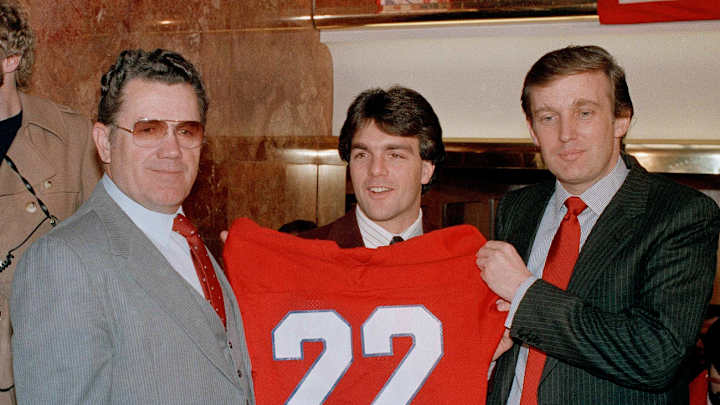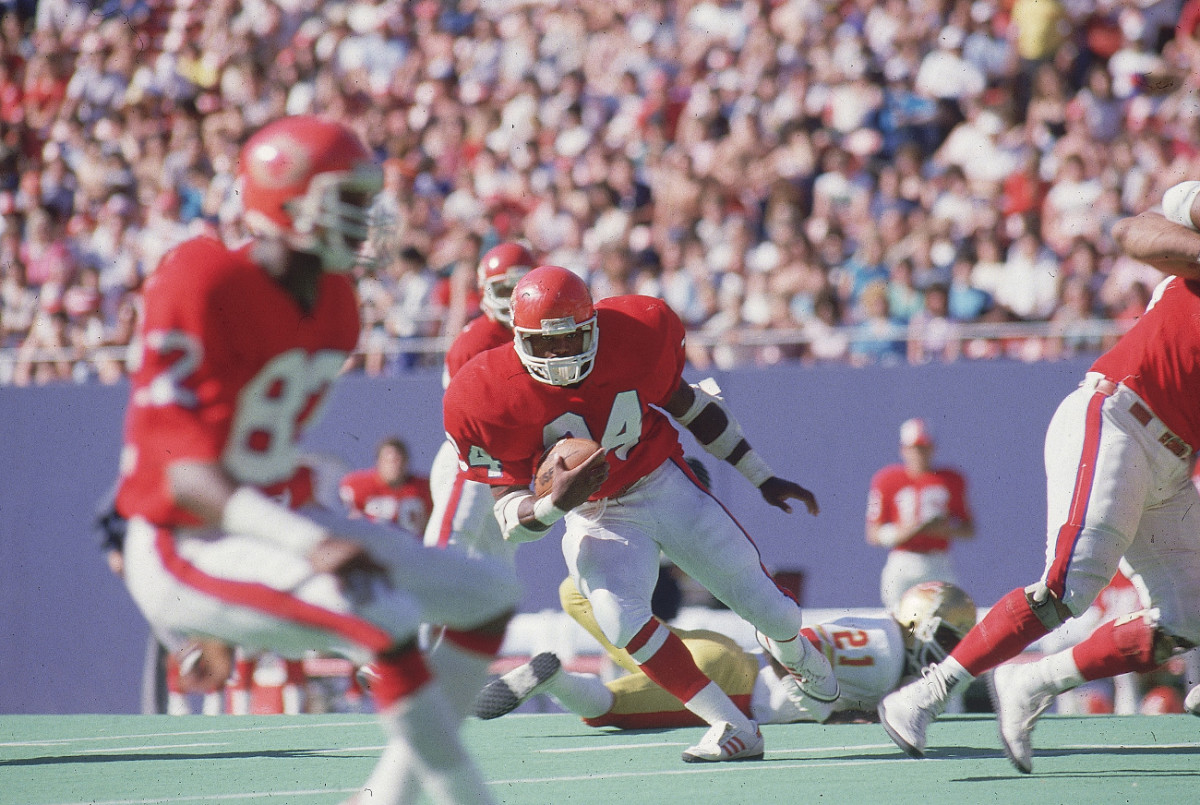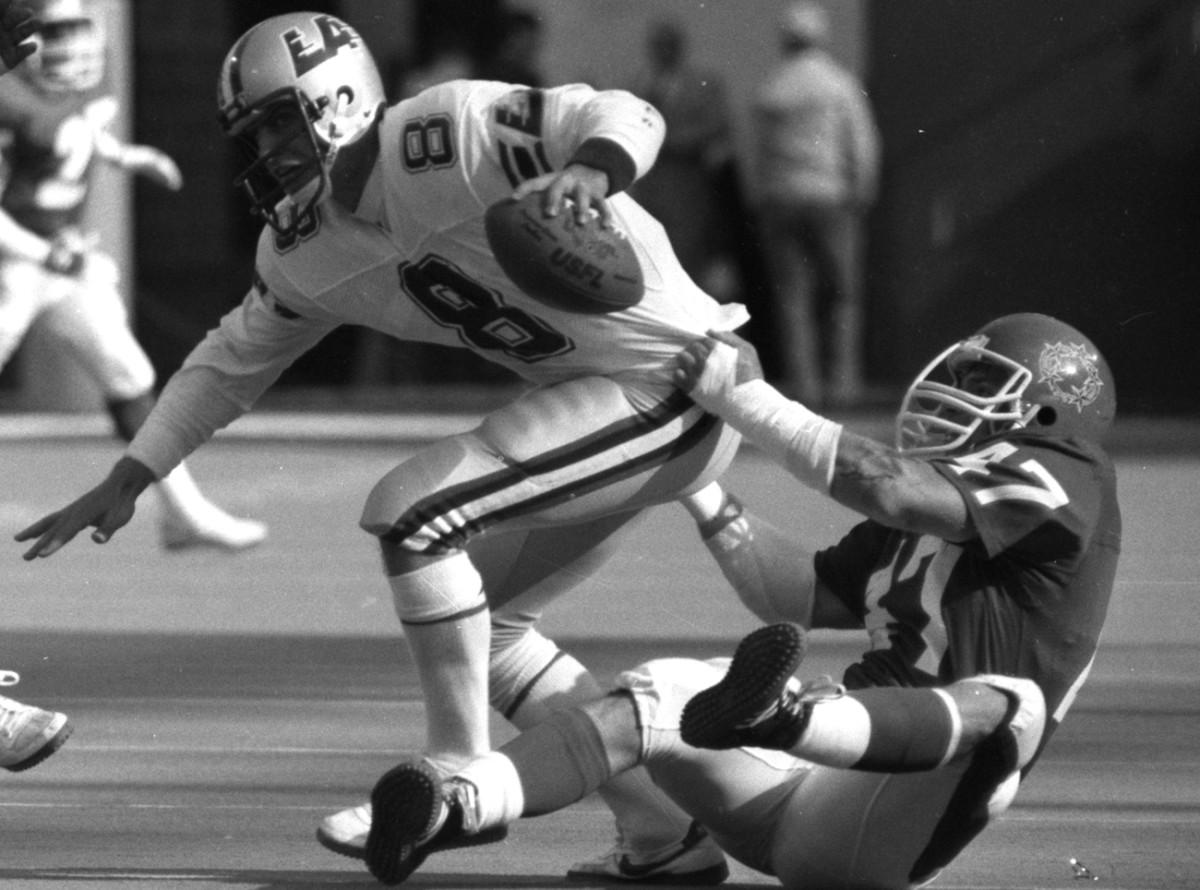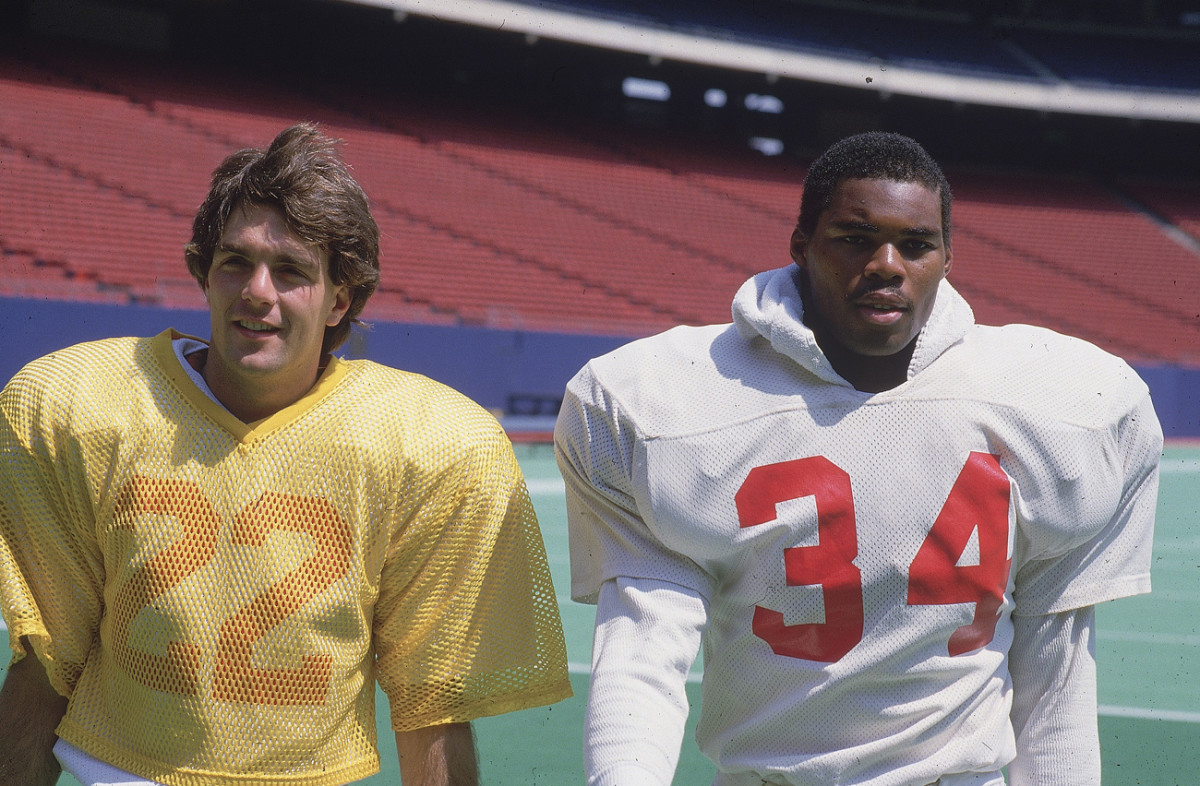Donald Trump and the USFL: A ‘Beautiful’ Circus

It was the offseason for the USFL and the draft was approaching when Donald Trump, the New Jersey Generals’ owner, met with head coach Walt Michaels to discuss their plans for the roster. They had decided they needed a new quarterback to breathe life into their offense, and now they were arguing over which one to target.
Michaels, with his old-school mentality, wanted Randall Cunningham from UNLV. Cunningham looked like a prototypical quarterback, tall and lean, and Michaels liked how he threw the deep ball. Plus, he would be the best punter in the league.
But Trump wanted Doug Flutie, the Heisman Trophy winner from Boston College. Flutie was arguably the most famous college player in the country, thanks in part to his memorable Hail Mary pass to beat Miami. Trump felt Flutie was more exciting, more marketable, a star in the making.
Michaels tried explaining to Trump why Cunningham was the wiser choice, and he brought in two assistant coaches for a demonstration. He pointed to his defensive coordinator, who stood about 6’3”, and told Trump he wanted a quarterback of that size. Not one the size of his wide receivers coach, 5’9”.
But Trump wasn’t having it, according to a source with knowledge of the Generals’ inner workings. Trump wanted Flutie, and it was his team, and that was that. The Generals drafted Flutie, and Trump signed him to a six-year deal worth about $8.3 million, instantly making Flutie the highest paid player in all of football at the time. In his rookie year, 1985, Flutie would earn nearly 40 percent more than Joe Montana would that NFL season, coming off a Super Bowl win.
The Generals bought radio spots around New York calling Flutie the “Miracle Man.” Trump held a press conference introducing his new quarterback at Trump Tower, in its gilded lobby covered in marble, in front of a grand waterfall. The league commissioner attended. The proceedings lasted 50 minutes in all. Michaels even presented Flutie a gift-wrapped playbook.

“The kid is a media phenomenon,” Trump told the New York Times once Flutie reported to training camp in Florida. “The look of the kid. The girls waiting in the Orlando airport.”
Big-name players. Big money. Big press conferences. That was how it worked for Donald Trump when he owned the New Jersey Generals of the USFL, the football league that tried to challenge the NFL in the ’80s by playing in the spring. Trump bought the team after its inaugural season, owned it for two seasons thereafter, and was, by some measures, a good owner. He spent lots of money, poached several players from the NFL and raised the overall profile of the league. After going 6-12 that first year, the Generals produced a 25-11 regular-season record in their two years under Trump.
• PUNTING ON POLITICS: Why players are steering clear of the political arena in the 2016 election
Not everything was glitz and gold, though. Trump ran the team as he might any of his other business ventures, and that left a sour taste at times, or worse. By the time the USFL folded, Trump had alienated many people around the team and across the league.
* * *

After one Generals win, Gary Croke, the teams’ assistant public relations man, was hanging around the locker room when a Trump assistant approached him. “Listen, I need you to take Donald Jr. and his classmates into the locker room to meet Herschel Walker.”
Croke was incensed. Take a bunch of kids into the postgame locker room?
“That’s a direct order from Donald,” the assistant added.
And so Croke took young Donald Trump Jr. by the hand and led him and his grade-school classmates through the sweaty room full of reporters and half-naked players. The children, dressed in blazers and ties, went to the back of the room, where Walker was addressing a large group of reporters, and Croke parted the crowd, interrupted the interview and had the children meet Walker right then and there.
Trump had a different relationship with the star players, especially Walker, the Heisman Trophy-winning running back who was the Generals’ best player when Trump bought the team. At the time, Walker didn’t know much about Trump, he said, other than reading that he was “this young guy doing some amazing things in the business world.” The first time they met, Walker remembered being awed by the quality of Trump’s suit.
“This guy is dressed nice, looks nice,” Walker said. “Everything is in place. He looked professional. When he took over the team, he brought a class to that team. I remember my mom always used to say, ‘When you do anything, dress like you know what you’re doing.’ ”
A friendship blossomed. They had dinner together, started hanging out away from the field. Walker attended Trump’s events, met his business associates, got to know his family. When Donald Jr. visited the team, Walker played with him. The Trump children viewed him like an uncle. A few times, Walker took Donald Jr. and Ivanka to the Bronx Zoo.
“At the time, my wife and I didn’t have any kids,” Walker said. “And I was brought up in a large family with a lot of kids around and stuff. It was just taking a friend’s kids to the zoo.”

During training camp, Walker took Donald Jr. to Disney World. Walker’s wife, his in-laws, and Donald Sr. came along, too. Always keeping appearances, Trump rode the rides all day in the hot sun wearing another nice suit, only allowing himself to remove the jacket.
The other players didn’t mind that Trump had a special relationship with Walker, because most of them enjoyed playing for Trump regardless. They had heard rumors about other USFL teams struggling financially, players racing to cash their checks on payday because the last one might have bounced. The Generals seemed to be on solid ground.
Trump installed Jimmy Gould as team president, built him an office down the hall from his own in Trump Tower, and spoke with him regularly. Gould, a man with league ties, had brokered the sale of the team for previous owner J. Walter Duncan and had gotten to know Trump in the process. Trump opened his checkbook, Gould said, and gave him access to anything and everything he needed, “to go after and build the team in the league.”
• SPECIAL THREE-PART SERIES ON THE MIND OF THE PLACEKICKER: ‘PITY THE KICKER’ | A LONELY WORLD | MAKES, MISSES AND THE AFTERMATH
Trump went after Don Shula, Joe Theismann, and Lawrence Taylor, and, though he didn’t sign any of them, it made for a good story. Seeing that Taylor was unhappy with his Giants contract, which had four years left on it, Trump invited Taylor to the Trump Tower and offered him a $1 million signing bonus on the spot, with the understanding that Taylor would join the Generals after his NFL deal expired. Taylor signed a contract that day, sending the Giants into a tizzy. They countered by re-paying Trump the $1 million—and giving him $750,000 to release Taylor from the contract.
Trump kept spending, signing former Jets coach Walt Michaels and filling out the roster with pricey NFL veterans—Brian Sipe, the Browns quarterback; Gary Barbaro, the Chiefs’ free safety; and Dave Lapham, a Bengals offensive lineman, among others. Trump ensured everything was top-notch, from the players’ food to the travel to the lodging. Walker compared Trump to Jerry Jones and Mark Cuban, as an owner who supported his players.
“He was about as good an owner as you could hope for,” Lapham said.

The average player didn’t see much of Trump, though. Most had only brief exchanges with the owner, usually pleasant, as he passed through the locker room after wins. Once after a game Trump stopped by the trainer’s room to check on John Joyce, a linebacker who had injured his knee. Trump talked with the doctor and said, as he left, “Listen, make sure John gets what he needs.”
“You’re thinking, alright this guy’s in my corner,” Joyce said. “He’s got my back.”
* * *
After Dave Lapham signed his contract with the Generals, in the owner’s office at Trump Tower, Trump suggested that Lapham go downstairs and join the festivities. As one of his first acts as owner, Trump was staging a competition to select the team’s cheerleaders. Hundreds of beautiful women had shown up for the first round. Ivana Trump, Donald’s wife, was designing the uniforms. Jimmy Gould, the team president, suggested they be called The Trumpettes.
And Trump had turned this final round into an event, girls lined up everywhere around the Trump Tower. “We were like two little kids in a candy store,” Gould said. Trump invited the media and stocked the judging panel with celebrities — his newest offensive lineman, his wife, the artist LeRoy Neiman, the opera singer Beverly Sills, and Andy Warhol. The judges gave scores as the girls danced to the same song, Michael Jackson’s hit “Billie Jean.”

Warhol had purposely arrived two hours late to the event. He wrote in his published diaries that he had gone to church that morning and taken his time coming over because he hated the Trumps for not buying some paintings he’d done of Trump Tower. That Warhol made it to the event at all says something about Trump’s status, socially and professionally, in New York City in the ’80s.
Trump had already established himself as a playboy and a real estate magnate. The Trump Tower had just opened. He and his wife were socialites around town. Those working for the Generals thought he viewed the team as another way to make headlines and promote his brand, which was why he turned a cheerleading competition into an event.
“He already had a good hold on Page Six,” said Charley Steiner, the Generals’ play-by-play announcer, referring to the New York Post’s famed gossip page. “By buying a football team, he bought his way onto the back page of the Post and the Daily News. On a good day, if he had a real estate deal go through, he could have had the back page, Page Six and the front page. A hat trick.”
• DOUG FLUTIE ON HIS CAREER: The USFL, NFL and CFL vet on why he loved playing up north
Trump made sure every major Generals press conference—like the one for Flutie—took place in the Trump Tower’s gilded lobby, in front of that grand waterfall. He didn’t seem to care that it wasn’t ideal for the media. Cameramen had to jostle for positioning because there wasn’t always enough space, and reporters often complained the waterfall was too loud.
But if a reporter wanted a one-on-one interview about the Generals, Trump hardly ever turned them down. He invited sportswriters to visit him at the Tower. Before seeing him, visitors would first have to sit in a theater room and watch a lengthy video about Trump, the Tower, and how he built his empire. “It was impressive as hell,” Lawrence Taylor wrote in his book. Then the person would be ushered into Trump’s office and be seated facing a large window with a gorgeous view of the city.
The interview itself wasn’t always as impressive. Sportswriters found that Trump spoke in generalities and made grand statements and would barely answer their questions. If they asked Trump about football, “he sort of went blank,” said George Vecsey, a longtime columnist and sportswriter for the Times. “We all knew more about football than him.”
Trump had decided he wanted a refund on his hand-picked quarterback, and disparaged Flutie in the media, using a fake name.
After a while the writers covering the team started wondering how straight Trump was being with them. The cheerleaders claimed that Trump lied to them, too. During their first season, eleven of the 30 cheerleaders staged a walkout, saying Trump had not delivered on promises to arrange acting jobs, modeling gigs and television appearances for them to supplement their modest pay. Instead, they said they were forced to wear skimpy outfits and entertain drunks at local bars. They felt unsafe. Actress Lisa Edelstein, who’d been one of the younger cheerleaders, told the Huffington Post last year Trump treated them “like hookers.”
Even Flutie, Trump’s prized quarterback, got some shabby treatment. After signing that mega contract, Flutie struggled as a rookie. He completed less than 50 percent of his passes, threw more interceptions than touchdowns and had his year cut short because of injury. Not halfway through the season, a publicist named John Barron, who said he was “vice president of the Trump Organization,” called the wire services and went on a rant about the deal. He said the other owners had asked Trump to sign Flutie “for the good of the league,” and that they had made a verbal agreement with Trump to help pay for the part of the contract.
“When a guy goes out and spends more money than a player is worth,” Barron told the press, “he expects to get partial reimbursement from the other owners.” Trump later said Barron was misquoted and that he had never said he had paid Flutie more than he was “worth.”
The Washington Post recently reported that, around that time, Trump would call reporters masquerading as a publicist named “John Barron.” Trump was Barron; Barron was Trump. After Trump overruled his head coach and hand-picked his quarterback, he had decided he wanted a refund and then disparaged his quarterback in the media, using a fake name.
* * *
In 1984, Trump’s first season owning the Generals, he allowed the USFL’s production team—the league’s equivalent of NFL Films—to tape him as he watched a game against the New Orleans Breakers from the owner’s box with his wife and the team’s general manager, Jim Valek.
Friends and acquaintances occasionally popped in to pay their respects, which gave Trump a chance to brag about his team. It was one of the perks he seemed to enjoy about being the owner. Otherwise, he sat there sipping Coca-Cola, his hands folded, making the occasional comment about the officiating. In between plays, he asked Valek football questions.
• A HISTORY OF PRO FOOTBALL IN 95 OBJECTS: Our series on the items that shaped the game
People other than the beat writers had wondered how much Trump knew about football. When making decisions regarding the team, he sometimes canvassed people until he reached a consensus. A few people joked that he even asked the janitor his opinion.
On one kickoff, the Generals’ kicker sent an awkward wobbler to about the five-yard line, and the returner was swarmed by tacklers as he struggled pick the ball up. Valek screamed during the play, while Trump watched quietly.
He turned to Valek. “How do you like that kick, Jim? Effective, right? Powerful.” He jabbed the air with his right fist twice to emphasize his point.
Effective if they can get him quickly, Valek replied.
“That’s what happens.”
“Yeah.”
Trump paused and then leaned over again. “Is that intentional, a kick like that?”
“No, no, I think he missed it.”
* * *

Trump had originally wanted an NFL team. Pete Rozelle, the NFL commissioner, revealed in 1986 that before buying the Generals, Trump had tried to purchase the Baltimore Colts. Rozelle responded through an intermediary and told Trump he was wasting his time. Trump denied that, saying in fact Rozelle had tried wooing him.
The NFL had spurned Trump, and, looking back, that appeared to color several decisions he made regarding the Generals and the USFL at large. Before the 1986 season, Trump pushed his fellow owners to move the games to the fall and compete directly opposite the NFL. “If God wanted football in the spring,” Trump once famously said, “he wouldn’t have created baseball.” The league wouldn’t command as much TV money that way, but many people believed the move was designed to force a merger, and that that was Trump’s goal.
In conjunction with the move to the fall, the USFL filed a $1.69 billion antitrust lawsuit against the NFL— another strategic decision Trump supported—arguing that the NFL was using its influence to persuade the three major networks not to broadcast the USFL. A jury ruled that while the NFL did indeed have a monopoly on pro football, it had not interfered with the USFL’s TV deals. The jury awarded the upstart league $3 in damages—$3.76, with interest.
The league essentially folded, and players had to scramble. Stars such as Herschel Walker had no problem finding work in the NFL. But dozens of role players like John Joyce, the linebacker Trump once visited in the trainer’s room, saw their football careers fizzle out. Joyce signed with the Packers, got cut just before the 1986 season and went to work on Wall Street.
In 2009, Trump agreed to be interviewed for an ESPN documentary that asked the question: “Who killed the USFL?” Trump had been widely blamed for hastening, if not directly causing, the demise of the league. Afterward, he asked the interviewer, Mike Tollin, what he thought of how the league had folded. Tollin had worked on the USFL production team. He told Trump he thought the USFL might have survived if only it had stayed the course, remaining a spring league.
“Would’ve been small potatoes,” Trump said, patting Tollin on the back and walking out.
* * *
Tollin and the USFL production camera that was filming Trump during that ’84 game was still rolling when the owner visited the locker room after beating the Breakers, 31-21, to clinch the franchise’s first playoff berth. The Generals would exit the playoffs in the first round both years under Trump, so this counted as one of his high points as owner.
“Congratulations, Donald,” someone said.
“O.K., beautiful, beautiful—beautiful,” Trump said, acknowledging the comment.
“Beautiful,” he said again to himself as he kept moving through the room.
He came upon a group of players at their lockers. “How’s it feel? Champs. Good to be champs, huh? Way to go.” He shook one player’s hand and shook a fist at another and kept going. He shook another player’s hand and came upon another group at their lockers. “Way to go, fellas, way to go.” He shook his fist again. “Now we’ve got to go a little further, right?”
Trump only made these types of visits after wins. Hardly ever, if ever, after a loss.

As the tape rolled, the media eventually found him, and he happily agreed to an interview, and, in the span of a few minutes, he managed to offend multiple parties. He gushed how the top USFL teams could beat “most of the teams in the NFL.” He trashed the previous Generals owner, Duncan: “We did a lot better than the team under other ownership last year. Last year the team really had a lot of problems, and they had a horrible record.” And Trump indicated he had disagreed with the coaches’ strategy of running a conservative offense in recent weeks. In the owner’s box during the game, Trump had repeatedly noted how the coaches were finally allowing Brian Sipe, his highly paid quarterback, to air the ball out.
• DR. Z—A LIFE IN JOURNALISM: The legendary Paul Zimmerman recounts his career covering pro football
A reporter asked if Trump had spoken to Walt Michaels about changing the offense.
Trump made a face. “Well, Walt and I always talk. And I thought it was something that … and I would never tell Walt—I have a great relationship with Walt. But Walt and I discuss the entire team. We were winning games, but we weren’t necessarily winning them, as you folks were saying, in a beautiful manner. But we were winning them. And then we had a bad game last week. And I think it’s a great tribute to the team and to Walt and to everything else that they literally changed the team around over the last week, and they came back, and they won, and they won big, and they won convincingly. I don’t think anybody has a more exciting offense than ours when it’s on. Today they opened it up. Brian Sipe was passing, and he was just super. We’re proud of him. It’s the first time that Brian’s been really allowed to drop back and pass as much as he did, and he showed that he’s just as good as Cleveland knew he was. And that’s why Cleveland tried so hard to sign him for an additional few years.”

In reality, the relationship between Trump and Michaels reminded some around the team of that between George Steinbrenner and Billy Martin. After Trump ignored Michaels’ wishes and replaced Sipe at quarterback with Flutie, instead of Cunningham, Trump pressured Michaels to highlight Flutie and Herschel Walker more in the offense. Once Trump told a Generals coach that “60 Minutes” correspondent Mike Wallace would be in his box that week, and that he wanted the coaches to ensure that Flutie threw for 400 yards and Walker rushed for 200.
“What does he know about football?” Michaels would grumble. “He should stay in his tower and leave me alone.”
The Generals coaches privately exacted their own revenge. They created a play called The Tower, modeled after something Steve Spurrier ran. It looked sort of odd. The two offensive tackles would spread wide one either side, bunched with two receivers. The center, the guards and the quarterback would line up as usual, with the running back positioned directly behind the quarterback. From the owner’s box, perhaps on purpose, the formation looked something like a T. The Generals may have used the play in a game only once.
“It failed miserably,” Croke, the PR man, said, chuckling. “It didn’t work at all.”
• Question or comment? Email us at talkback@themmqb.com.
